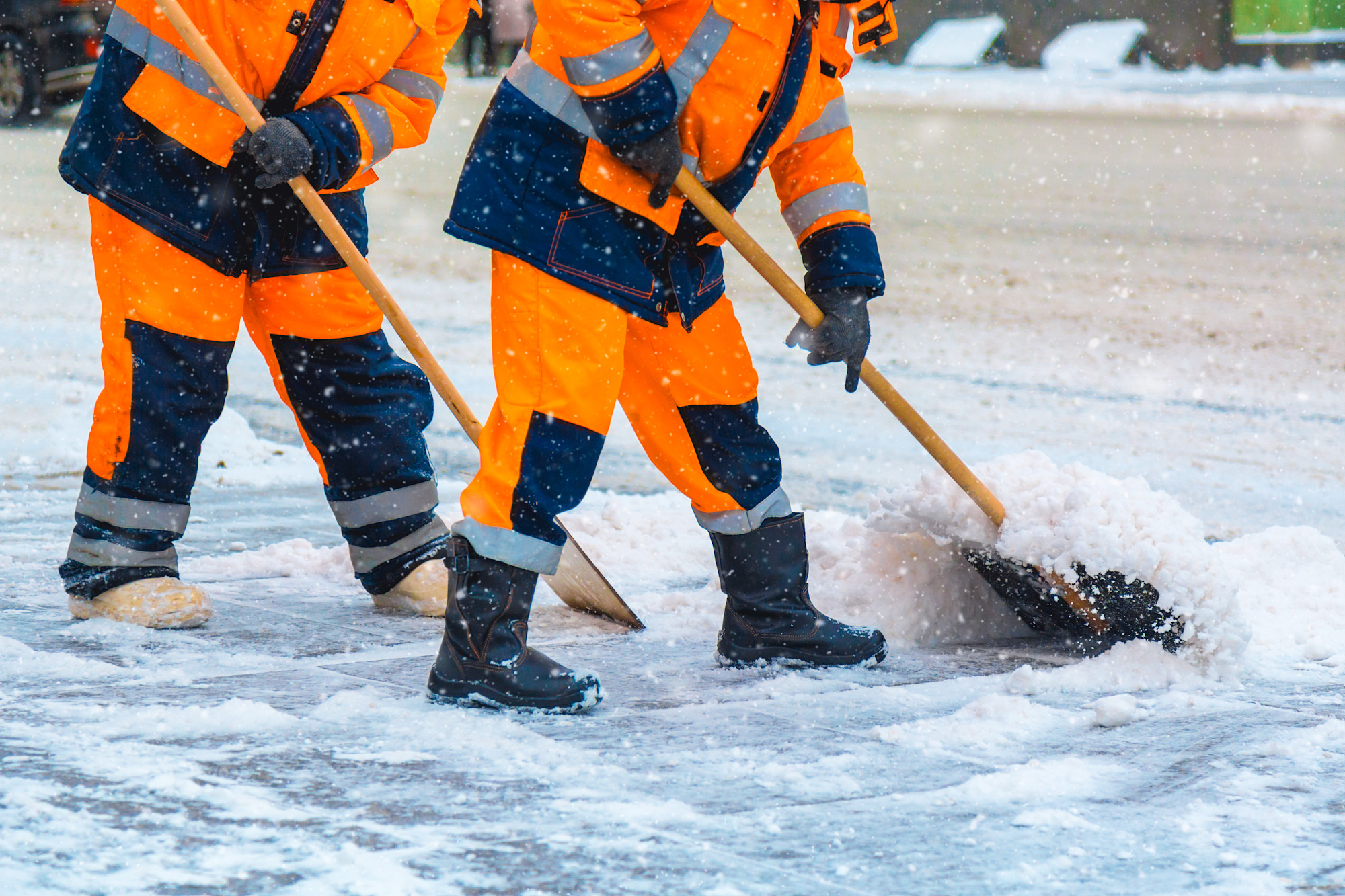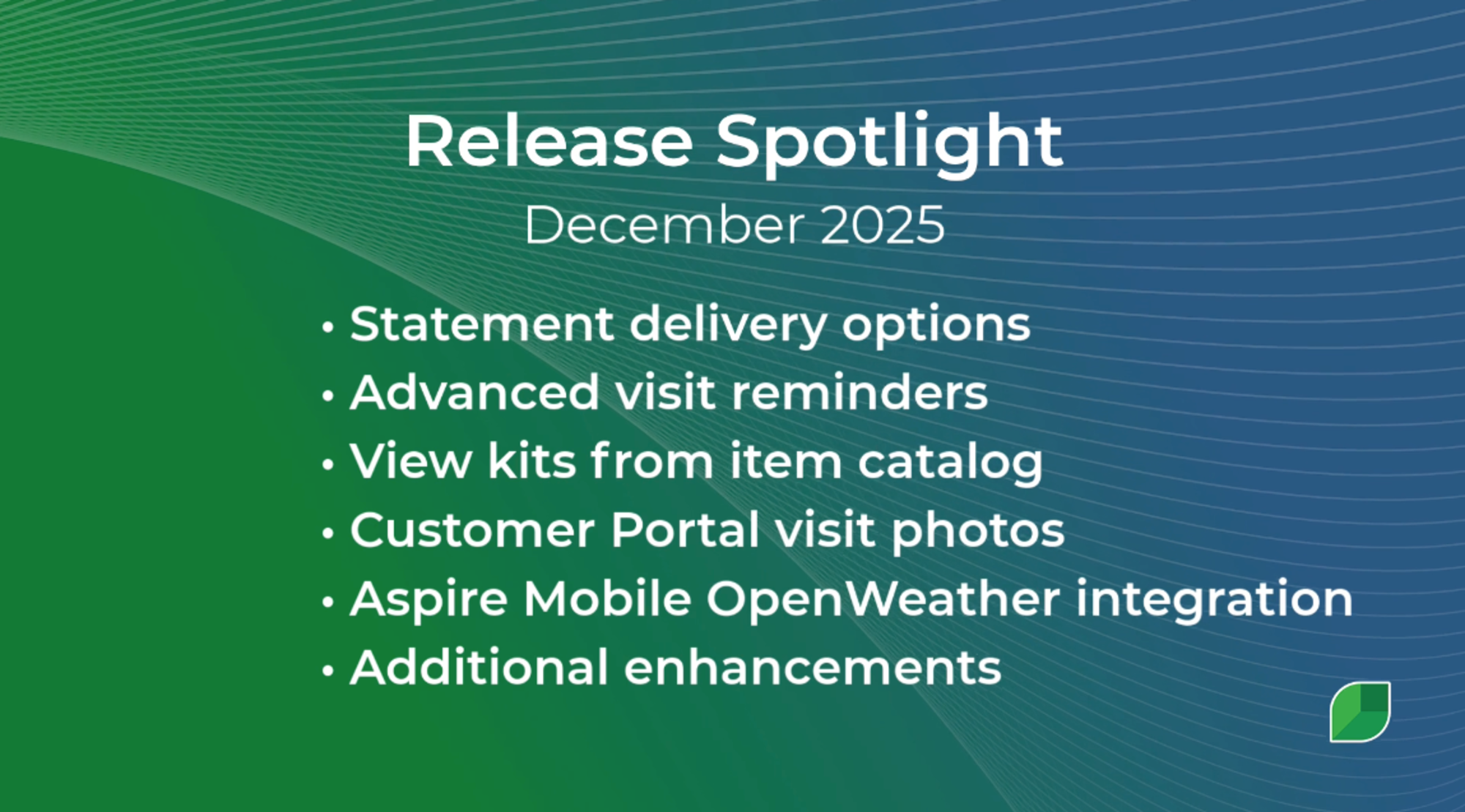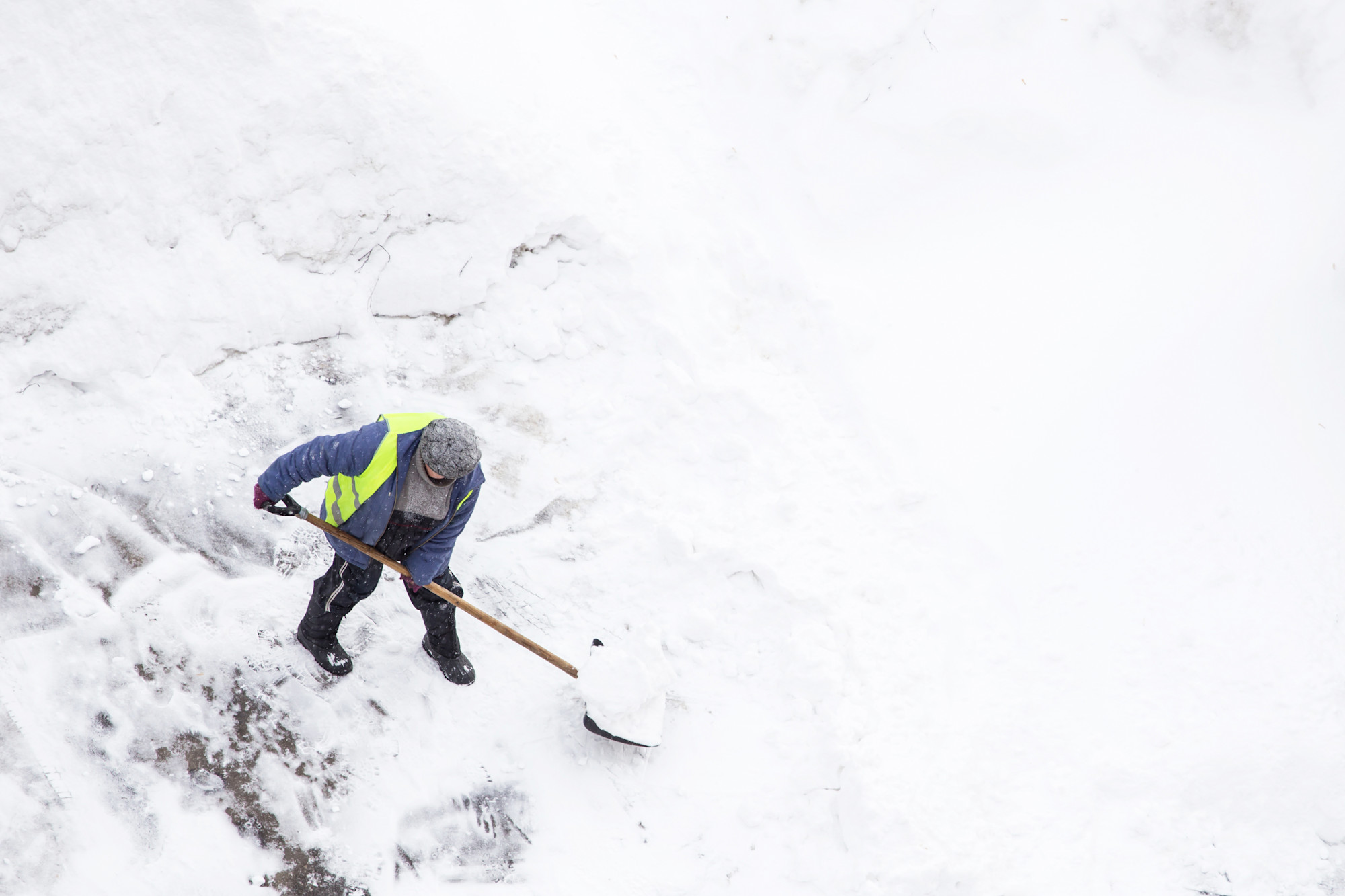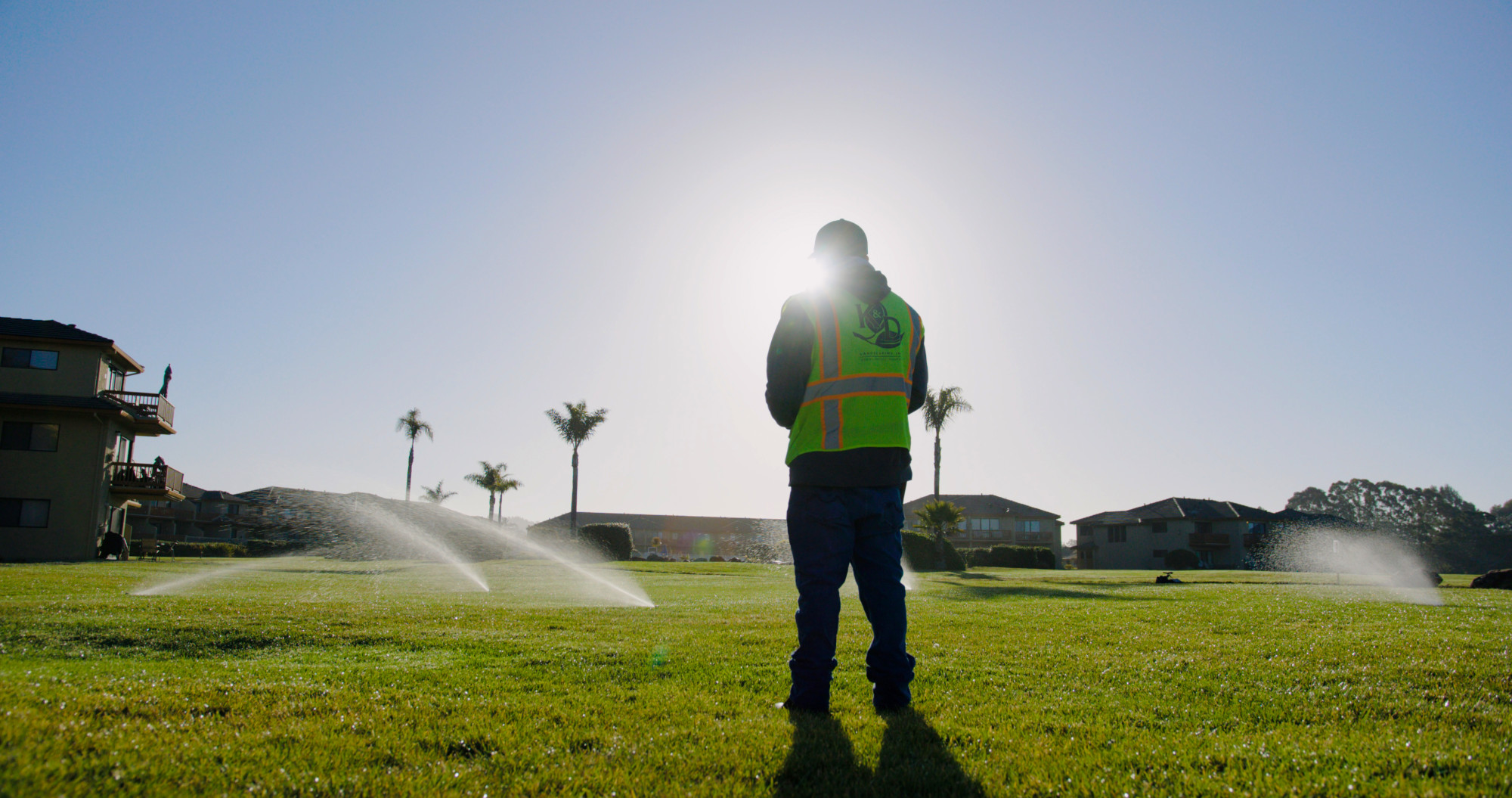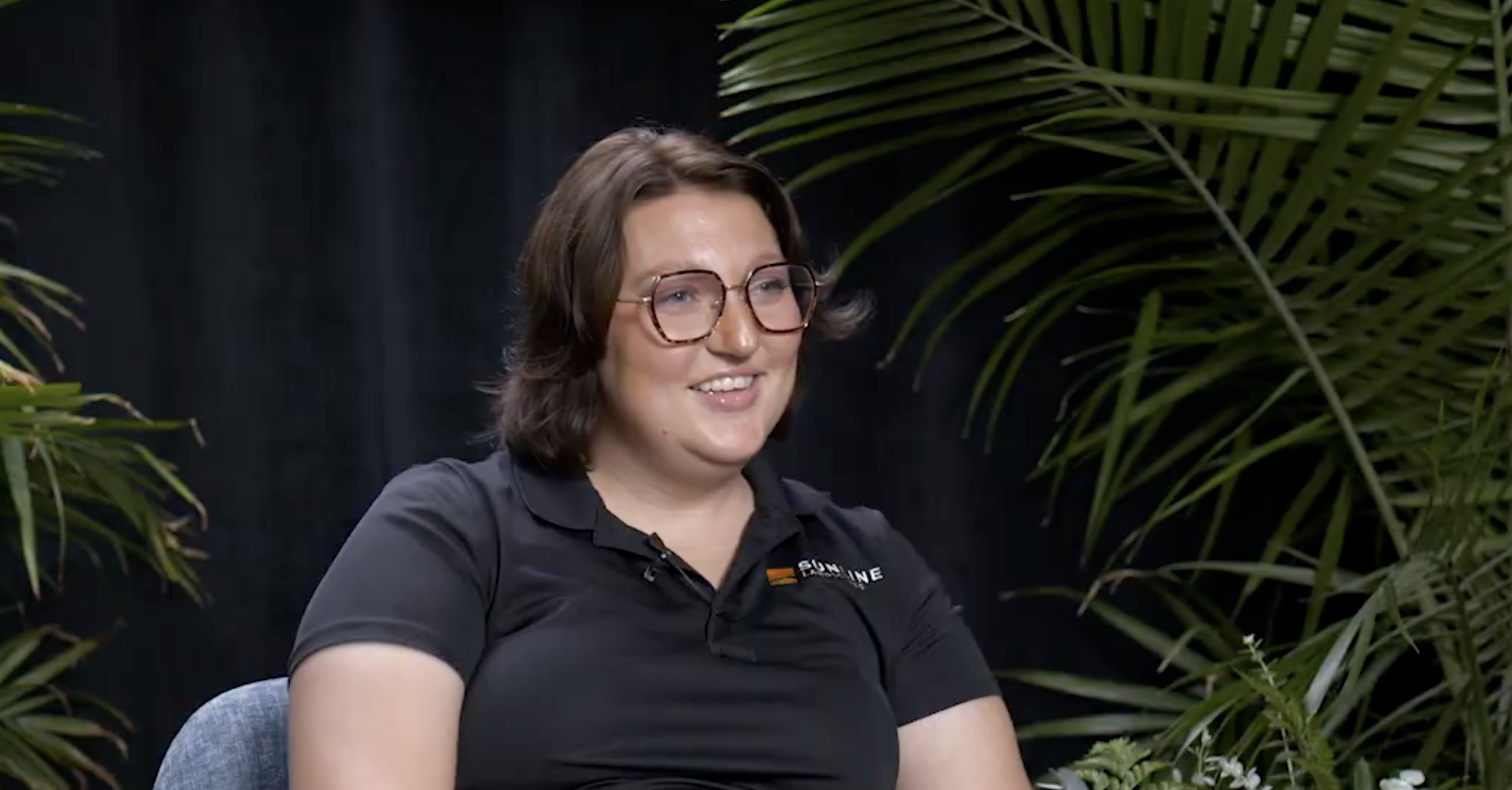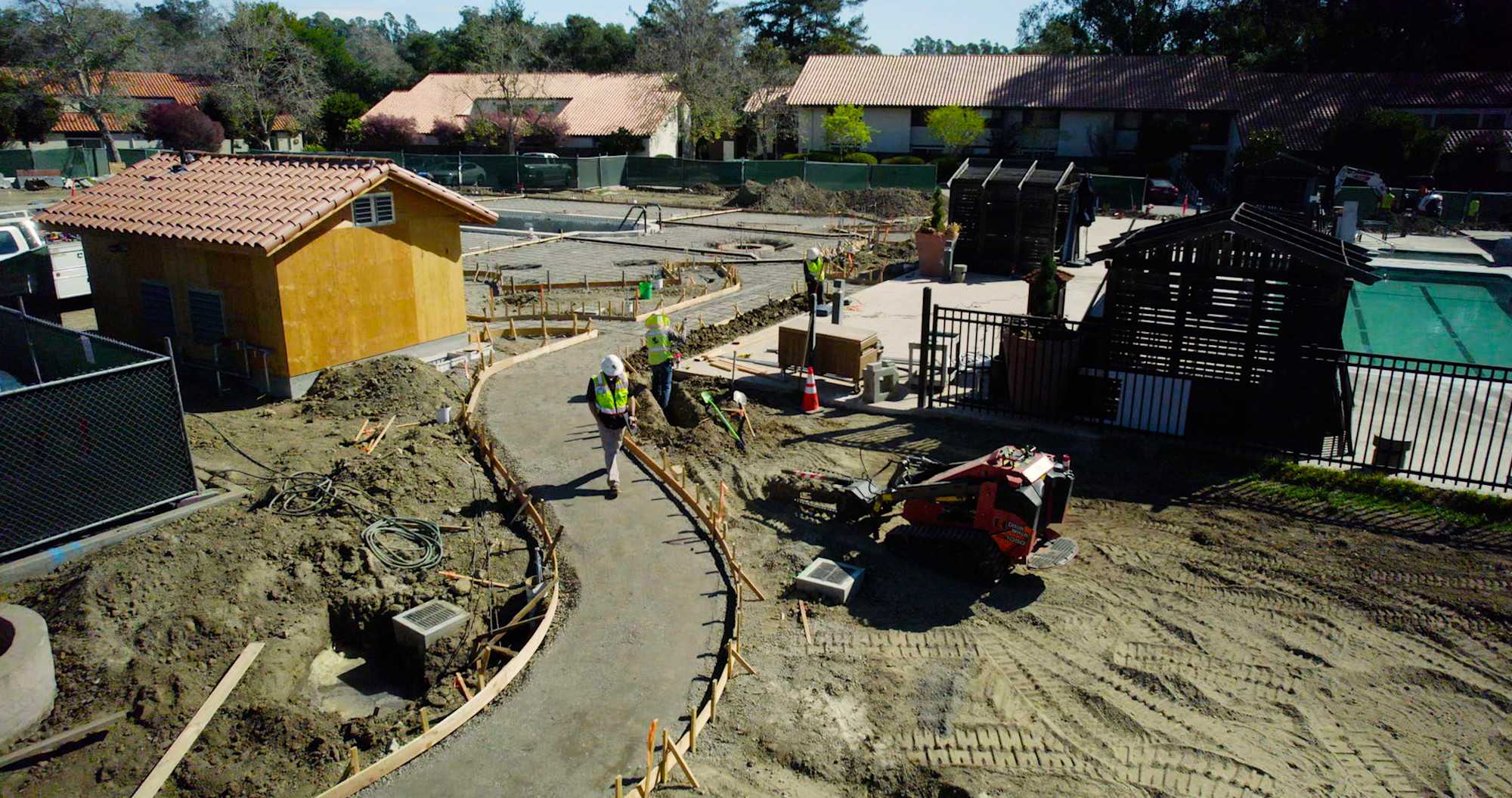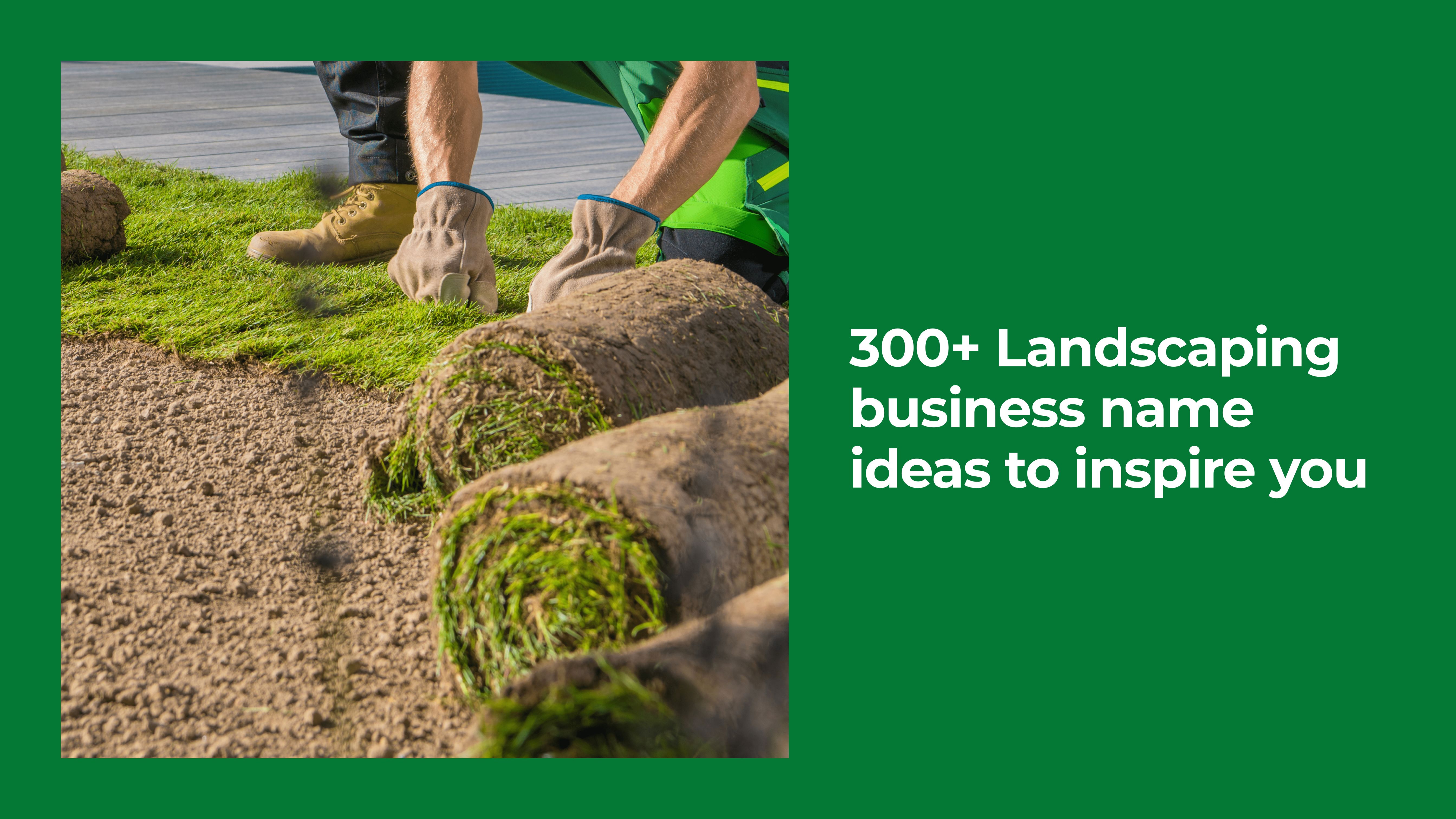Table of Contents
Table of Contents
- Why should you sell your used landscaping equipment?
- When should you sell your landscaping equipment?
- How to determine the right price for your equipment
- Where can you sell your landscaping equipment?
- Online marketplaces
- Industry-specific platforms
- Local sales
- How to prepare your equipment for sale
- How can you write a compelling listing that attracts buyers?
- What are the most important tips for negotiating and closing the sale?
- How can Aspire help you sell and manage landscaping equipment?
You’ve got some landscaping equipment to dispose of before it becomes obsolete.
But like many landscaping businesses, it’s been a challenge—from finding reliable buyers to deciding on a fair price and making the sale.
It’s a hassle. But it doesn’t have to be.
This guide is for landscaping contractors and professionals looking to turn their old equipment into cash.
It will take you through the entire process—valuation, listing, negotiating, and closing the sale.
Why should you sell your used landscaping equipment?
Consider selling your landscaping equipment if you need to:
Free up space & improve efficiency
Picture this: your warehouse is packed. There’s barely enough room to move, let alone store new equipment. You waste time navigating clutter, leaving new purchases in the open or the front office.
What’s the best way to reclaim space? Sell unused or outdated equipment to reclaim order in your storeroom while making operations smoother and more organized. Plus, you'll have space to keep new equipment.
Recover investment costs
Selling unused landscaping equipment is a smart way to recoup some of your initial investment.
Landscaping contracts can be seasonal, and keeping idle equipment ties up money that could be used elsewhere, like upgrading tools, boosting cash flow, or marketing your service.
Avoid depreciation losses
Unused landscaping tools degrade over time. Metal components become corroded and rusty, connectors stiffen, and the motor area fills with dust.
If you don’t service the equipment regularly, it gets damaged, and you lose the entire investment.
On the other hand, maintaining it costs more, especially since it doesn’t generate money.
To avoid total depreciation, it’s best to sell the unused equipment before it loses too much value.
Reduce maintenance costs
Keeping old landscaping tools means maintaining them regularly. Think deep cleaning, greasing or lubricating, sharpening the blades (where necessary), or pumping tires for motorized equipment.
All that maintenance costs money. And even if you’ve got a repair person on the team, that’s time that could have been spent on other revenue-generating activities.
Selling the equipment saves the expense and stress of ongoing maintenance.
Meet business changes
Considering downsizing your business, getting new equipment, or shifting focus to other businesses?
Selling unused equipment makes the transition smoother. Regardless of your next business move, sales provide extra cash to help keep the business afloat and fund new equipment.
When should you sell your landscaping equipment?
It’s time to say goodbye to your landscaping tools if:
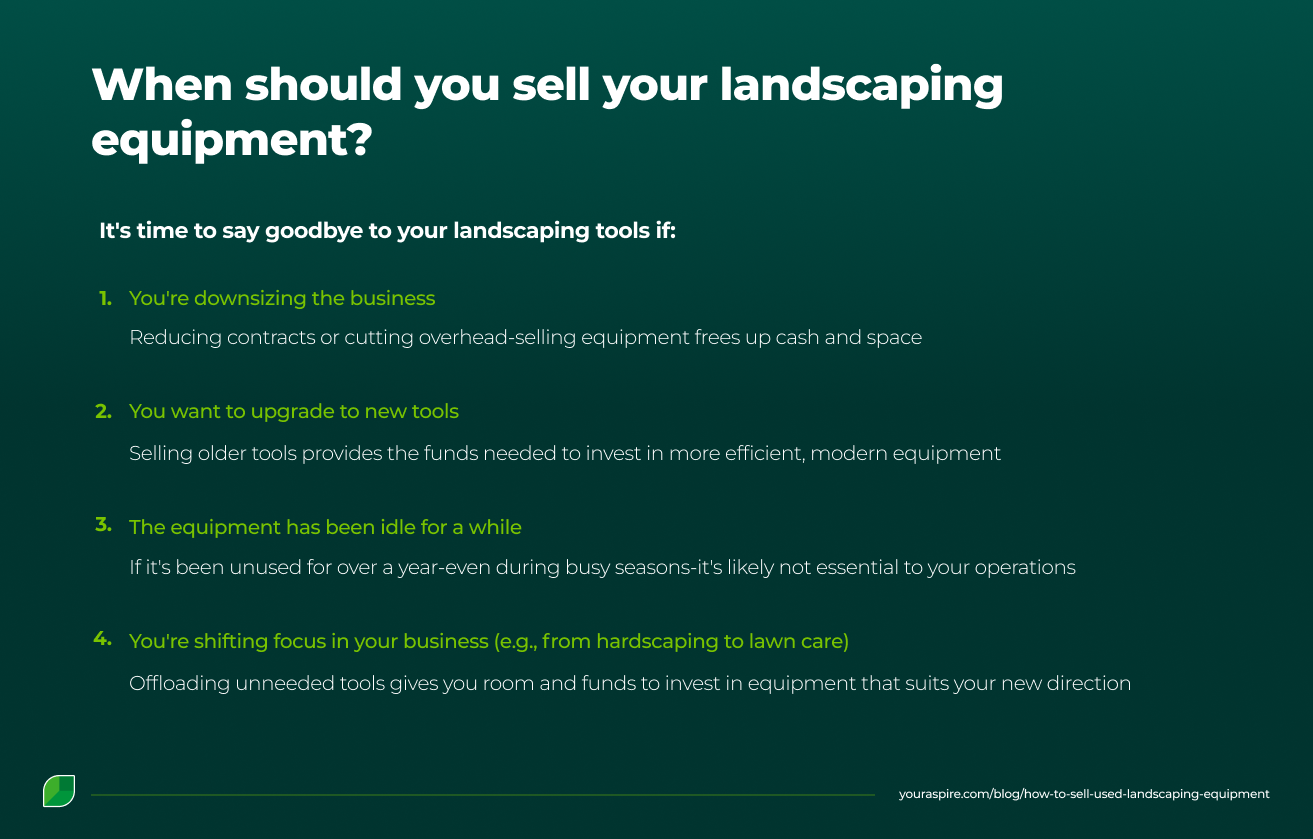
You’re downsizing the business. Perhaps you want to spend more time with family and can’t afford to take on as many contracts as you have. Or maybe maintaining the equipment is expensive, overhead costs are piling up, and scaling back makes sense.
You want to upgrade to new tools. A piece of new equipment has caught your eye, but there’s no liquid cash to fund it. Selling unused equipment can provide the money you need.
The equipment has been idle for a while. If the tool has been unused for over a year, even during peak seasons, it’s not a must-have equipment. Selling it will generate cash and create space for other tools.
You are shifting business focus. If you’re moving from hardscaping to lawn care, you will need different equipment. Selling existing tools provides space and funds for the new equipment.
Considering landscaping is a seasonal business, here are the best times of the year to sell your used equipment:
Spring: The busy season for many landscaping businesses, as homeowners and business owners want to get their yards in shape after winter. New and growing companies are looking to buy used equipment, so it’s an ideal time to sell to get a good value for unwanted equipment.
Summer: There’s a high workload, and landscapers wouldn’t mind a new tool for the right price, making it an ideal time to sell used equipment.
Fall and winter: If you need fast cash or want to dispose of a depreciated piece, many landscapers are looking for good deals on used equipment in fall and winter before the next busy season.
How to determine the right price for your equipment
To price used landscaping tools accurately, consider their condition and what similar items are selling for on the market.
Start by evaluating the equipment’s condition. Look at the:
Tool’s age. Unused or recently purchased landscaping equipment typically sells for more than older tools. According to users in a tools subreddit, well-maintained tools that still look new can sell for 40 to 60% of their original price.
So, if a new Toro TimeCutter costs $3,500, a fairly used one can be priced between $1,750 (50%) and $2,100 (60%).
Equipment’s status. Is the tool in perfect working condition or needs some repair? A functioning tool will fetch you a higher price than a piece that the buyer needs to fix.
Service records. How many times has the equipment been repaired? Tools with a history of frequent repairs may mean lower prices because buyers perceive them as unreliable.
Next, do market research to learn about current prices.
Visit online marketplaces like Craigslist, Facebook Marketplace, or eBay to compare prices.
Take note of the asking prices, how long listings stay up, and what brands or models are in demand.
Where can you sell your landscaping equipment?
Now, for the part you’ve been waiting for.
The top places where you can sell used landscaping equipment fall into three main categories.
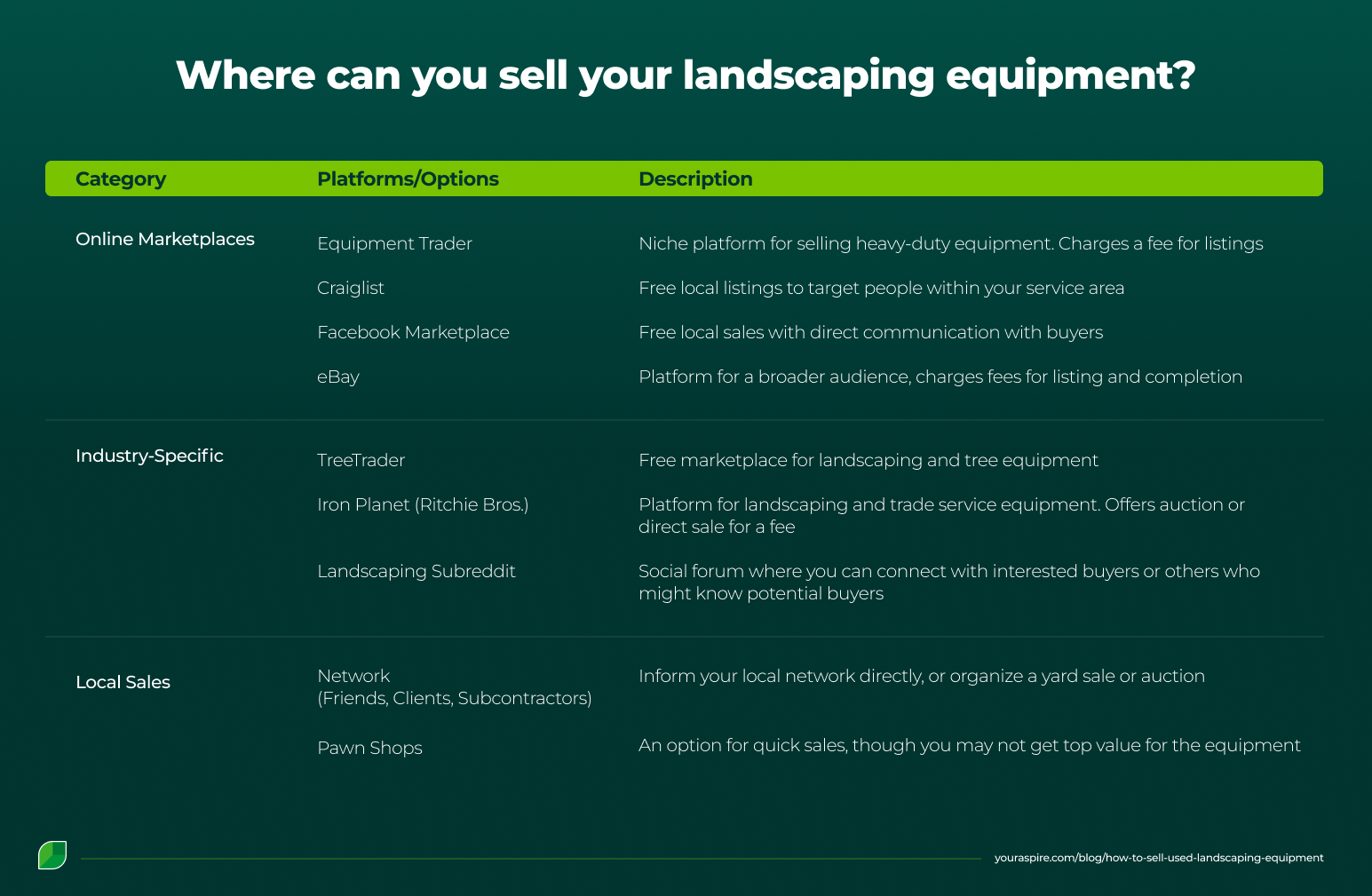
Online marketplaces
These platforms allow you to list equipment, some for free and others at a cost. They show your listings to a broad audience of landscapers, homeowners, and contractors looking for equipment.
Equipment Trader: This niche platform lets you sell heavy-duty equipment for a fee.
Craigslist: It’s a perfect option if you want to advertise your equipment for free to people within your service area. When listing, you just need to select the appropriate category, such as service trade.
Facebook Marketplace: Another free option for local sales. Here, you can chat with buyers and confirm their interests.
eBay: Use this option if you’re open to shipping the equipment or a bidding war. eBay charges $20 to list landscaping equipment and a 3% fee when the sale is completed.
Pros:
Offers a broad audience reach.
Streamlined listing process.
Free to low-cost listing fees.
Cons:
Might attract buyers outside your city, which means factoring in logistics.
High risk of scams.
Competition among other listings.
Industry-specific platforms
Use these platforms to attract landscapers and other trade service professionals. Posting here helps you attract serious buyers.
TreeTrader: A free online marketplace for selling landscaping and tree equipment.
Iron Planet: Also known as Ritchie Bros. Auctioneers, this platform sells landscaping and other trade service equipment for a fee. You can assign a price to the tool or set it for auction.
Another option is to list the equipment on social forums like a landscaping subreddit. There, you can find interested buyers or users who know someone.
Pros:
Attracts serious buyers.
Reasonable pricing for specialized tools like the lawn aerator.
They’re credible and boost buyers’ confidence.
Cons:
It could take longer to sell.
Requires detailed photos and listings.
Listing and selling fees are common.
Local sales
Consider telling people within your network—industry friends, clients, or subcontractors—about the equipment you want to offload. They might be interested or know someone who will be.
If you’re selling many tools, organize a yard sale or specialty auction that specializes in landscaping tools to attract interested buyers.
Another option is to take the equipment to a pawn shop. Remember that you may not get the best value for the tool.
Pros:
No listing fees.
Instant payment and pickup.
Build relationships with buyers.
Cons:
It can be time-consuming.
Narrow audience reach.
May not get the best price.
How to prepare your equipment for sale
After choosing where to sell your landscaping equipment, the next step is to get it ready for sale. Here’s how to do that:
Clean the equipment, be sure to wipe off any dust and debris.
Maintain it by keeping it well-greased and sharp. Conduct periodic checks to ensure it’s ready for the next owner.
Keep maintenance records for buyers. This helps justify your asking price by indicating the likelihood of future problems.
Attach the brochure about the equipment if you still have it. It shows buyers you’ve invested in maintaining the tool.
Have the receipt readily available for transparency to confirm the authenticity of the equipment.
Pour a small amount of gasoline into machinery like lawn mowers so potential buyers can test it.
Take multiple high-quality photos and write compelling product descriptions for online marketplaces.
Speaking of listing descriptions, find out how to create one below.
How can you write a compelling listing that attracts buyers?
Think of product descriptions as a short guide compelling prospects to check out which listing. If they’re exciting enough, people will want to click on them.
Here’s how you can create interesting descriptions for your equipment listing:
Be honest in the description. This builds trust with potential buyers. If the equipment has defaults, write them out.
Craft a catchy headline. For example:
‘Two-year-old TimeCutter 50” Zero Turn Mower in excellent condition’
Highlight unique details such as purchase date, major defects, and maintenance history. For instance:
Asking price: $2,100
24.5 HP Toro V-Twin engine
50" fabricated cutting deck
MyRIDE suspension system for a smooth ride
Only 55 hours of use
Recently serviced (oil change, blade sharpened, air filter cleaned)
Always stored in a covered shed
No mechanical issues or cosmetic damage
Purchased: 2023
Tell the equipment’s story. People love stories, so explain why you’re selling the tool or how well it was taken care of.
“Why I’m Selling: We’re switching business focus and downsizing equipment inventory to reduce overhead cost. This used TimeCutter 50” Zero Turn Mower once helped us cover 4 acres per hour. It still runs like new—perfect for light commercial use.”
List other essential information, such as what’s included with the equipment. Are there extra sets of blades or an operator’s manual?
Include relevant keywords, such as used lawn mowers or used TimeCutter 50” Zero Turn Mower, to increase the listing’s visibility on search engines.
Pro tip: After writing the listing description, use this checklist to verify its appeal:
Does the description make you want to buy the equipment?
As a customer, does it leave you with more or no questions?
Is it honest?
Is it clear and concise?
What are the most important tips for negotiating and closing the sale?
Want to ensure you have a smooth negotiation and sales process?
Here’s what to keep in mind:
Understand the worth of the equipment: Knowing the value of your landscaping equipment helps you approach negotiations with confidence and fairness.
For example, if a lawn tractor costs $10,000 and you have a five-year-old piece, understanding the value allows you to justify the asking price and find common ground with buyers.
Set a firm but fair price: Choose a price that reflects the equipment’s value while leaving room for negotiation with the buyer. Be upfront about why you’re asking for that amount. Is it based on the equipment’s age, condition, or market demand?
Highlight key selling points: Emphasize the equipment’s major features. Is it a comfortable tool for older professionals? Does it still have warranty coverage? Essentially, reinforce why the equipment is worth the price.
Use secure payment methods: When receiving payments, use trusted payment methods like Google Pay, Apple Pay, Stripe, and bank transfers. This helps avoid delays and protects you from potential scams.
Finalize pickup/delivery terms: Confirm the logistics arrangement before payment. Will you deliver the equipment, or should the buyer pick it up? If you’re delivering, clarify who covers the cost. Set a pickup time that works for both parties.
How can Aspire help you sell and manage landscaping equipment?
When juggling multiple landscaping projects and having a yard full of equipment, it’s hard to track what needs maintenance or should be sold.
But it doesn’t have to be with Aspire by your side.
Aspire helps you:
Track equipment value and depreciation: Aspire’s equipment feature gives you access to each tool’s maintenance history and provides depreciation reports for every equipment logged into the system.
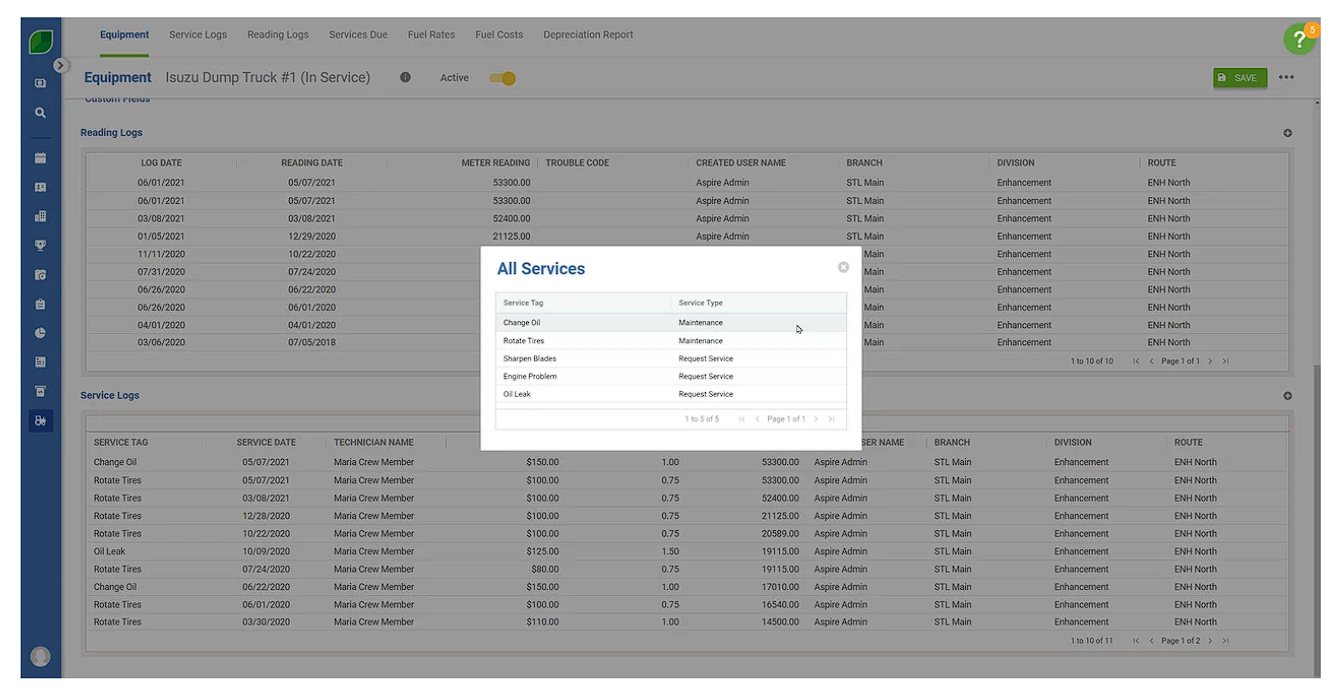
This helps you monitor equipment value, so you know exactly when the right time to sell is.
Simplify inventory management: Aspire helps landscaping businesses stay organized by tracking equipment and maintaining a record of current, past, and present assets.
It’s valuable information that keeps you in control of your inventory, allowing you to know which tools to sell and when.
Optimize financial planning: Access detailed insights into your business performance with Aspire’s reporting. Learn which landscaping services generate the most revenue and which tools are becoming outdated.
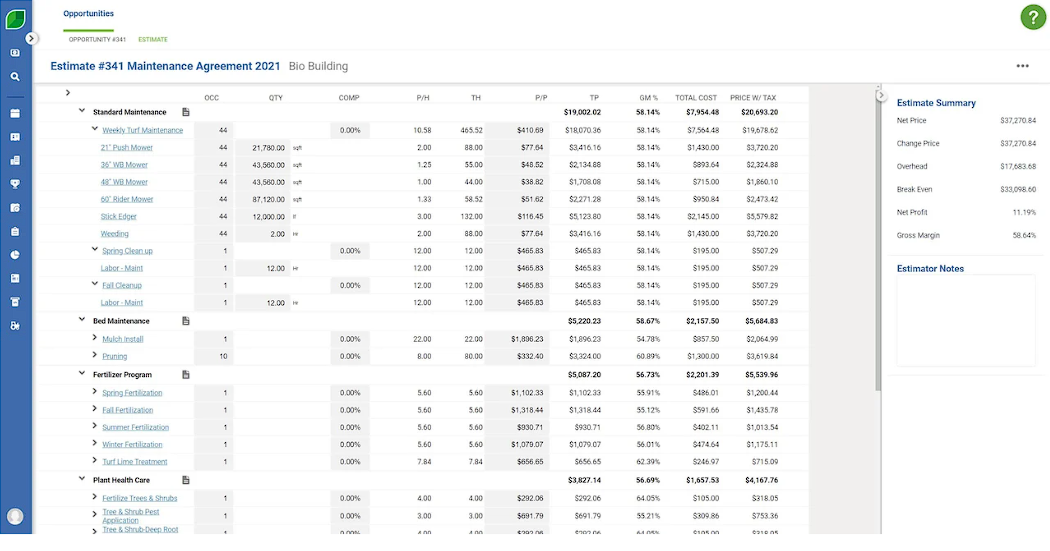
Instead of wondering where to reinvest the profits, these reports help you figure it out and allocate funds where they’ll have the most impact.
Overall, Aspire streamlines operations across your landscaping business.
When The Greenery needed to move away from siloed Excel spreadsheets, pivot tables, and department-specific software to a solution that integrated operations across all teams, Aspire stepped in.
According to the company’s chief technology officer, Janet DeNicola, their operations team now uses the platform to organize tickets, track hours, communicate with customers, and provide estimates.
The business development team uses Aspire to follow a lead’s progress from proposal to account management and report creation. The accounting team uses it to process accounts and move data from Aspire into the payroll system for seamless and efficient delivery.
Book a free demo with Aspire to get the kind of turnaround The Greenery did.

